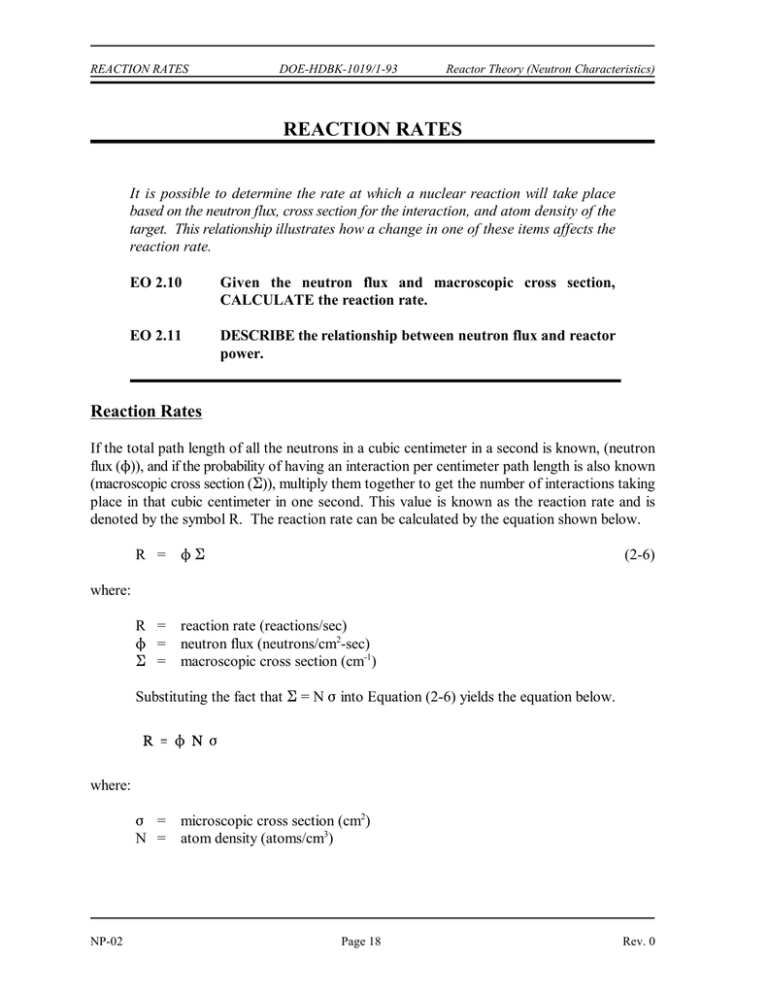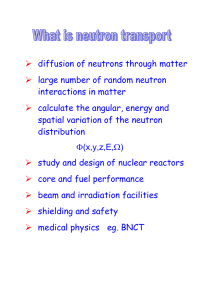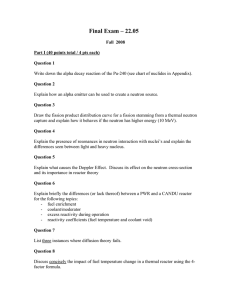neutron flux and reactor power
advertisement

REACTION RATES DOE-HDBK-1019/1-93 Reactor Theory (Neutron Characteristics) REACTION RATES It is possible to determine the rate at which a nuclear reaction will take place based on the neutron flux, cross section for the interaction, and atom density of the target. This relationship illustrates how a change in one of these items affects the reaction rate. EO 2.10 Given the neutron flux and macroscopic cross section, CALCULATE the reaction rate. EO 2.11 DESCRIBE the relationship between neutron flux and reactor power. Reaction Rates If the total path length of all the neutrons in a cubic centimeter in a second is known, (neutron flux (1)), and if the probability of having an interaction per centimeter path length is also known (macroscopic cross section (*)), multiply them together to get the number of interactions taking place in that cubic centimeter in one second. This value is known as the reaction rate and is denoted by the symbol R. The reaction rate can be calculated by the equation shown below. R = 1* (2-6) where: R = reaction rate (reactions/sec) 1 = neutron flux (neutrons/cm2-sec) * = macroscopic cross section (cm-1) Substituting the fact that * = N ) into Equation (2-6) yields the equation below. 1 ) where: ) = microscopic cross section (cm2) N = atom density (atoms/cm3) NP-02 Page 18 Rev. 0 Reactor Theory (Neutron Characteristics) DOE-HDBK-1019/1-93 REACTION RATES The reaction rate calculated will depend on which macroscopic cross section is used in the calculation. Normally, the reaction rate of greatest interest is the fission reaction rate. Example: If a one cubic centimeter section of a reactor has a macroscopic fission cross section of 0.1 cm-1, and if the thermal neutron flux is 1013 neutrons/cm2-sec, what is the fission rate in that cubic centimeter? Solution: Rf f neutrons 1 x 1013 cm 1 x 1012 2 0.1 cm 1 sec fissions cm 3 sec In addition to using Equation (2-6) to determine the reaction rate based on the physical properties of material, it is also possible to algebraically manipulate the equation to determine physical properties if the reaction rate is known. Example: A reactor operating at a flux level of 3 x 1013 neutrons/cm2-sec contains 1020 atoms of uranium-235 per cm3. The reaction rate is 1.29 x 1012 fission/cm3. Calculate f and f. Solution: Step 1: The macroscopic cross section can be determined by solving Equation (2-6) for f and substituting the appropriate values. Rf f Rf f 1.29 x 1012 3 x 1013 0.043 cm Rev. 0 fissions cm 3 sec neutrons cm 2 sec 1 Page 19 NP-02 REACTION RATES DOE-HDBK-1019/1-93 Step 2: Reactor Theory (Neutron Characteristics) To find the microscopic cross section, replace for f. Rf N f with (N x f) and solve f Rf f N 1.29 x 1012 1 x 1020 4.3 x 10 22 atoms cm 3 fissions cm 3 sec 3 x 1013 neutrons cm 2 sec 1 barn cm 2 1 x 10 24 cm 2 430 barns Reactor Power Calculation Multiplying the reaction rate per unit volume by the total volume of the core results in the total number of reactions occurring in the core per unit time. If the amount of energy involved in each reaction were known, it would be possible to determine the rate of energy release (power) due to a certain reaction. In a reactor where the average energy per fission is 200 MeV, it is possible to determine the number of fissions per second that are necessary to produce one watt of power using the following conversion factors. 1 fission 1 MeV 1 erg 1 watt = = = 200 MeV 1.602 x 10-6 ergs 1 x 10-7 watt-sec 1 erg 1 x 10 7 watt sec 1 MeV 1.602 x 10 6erg 1 fission 200 MeV 3.12 x 1010 fissions second This is equivalent to stating that 3.12 x 1010 fissions release 1 watt-second of energy. NP-02 Page 20 Rev. 0 Reactor Theory (Neutron Characteristics) DOE-HDBK-1019/1-93 REACTION RATES The power released in a reactor can be calculated based on Equation (2-6). Multiplying the reaction rate by the volume of the reactor results in the total fission rate for the entire reactor. Dividing by the number of fissions per watt-sec results in the power released by fission in the reactor in units of watts. This relationship is shown mathematically in Equation (2-7) below. th P f 10 3.12 x 10 V (2-7) fissions watt sec where: P th f V = = = = power (watts) thermal neutron flux (neutrons/cm2-sec) macroscopic cross section for fission (cm-1) volume of core (cm3) Relationship Between Neutron Flux and Reactor Power In an operating reactor the volume of the reactor is constant. Over a relatively short period of time (days or weeks), the number density of the fuel atoms is also relatively constant. Since the atom density and microscopic cross section are constant, the macroscopic cross section must also be constant. Examining Equation (2-7), it is apparent that if the reactor volume and macroscopic cross section are constant, then the reactor power and the neutron flux are directly proportional. This is true for day-to-day operation. The neutron flux for a given power level will increase very slowly over a period of months due to the burnup of the fuel and resulting decrease in atom density and macroscopic cross section. Rev. 0 Page 21 NP-02 REACTION RATES DOE-HDBK-1019/1-93 Reactor Theory (Neutron Characteristics) Summary The important information in this chapter is summarized below. Reaction Rates Summary & The reaction rate is the number of interactions of a particular type occurring in a cubic centimeter of material in a second. & The reaction rate can be calculated by the equation below. R=1* & NP-02 Over a period of several days, while the atom density of the fuel can be considered constant, the neutron flux is directly proportional to reactor power. Page 22 Rev. 0




